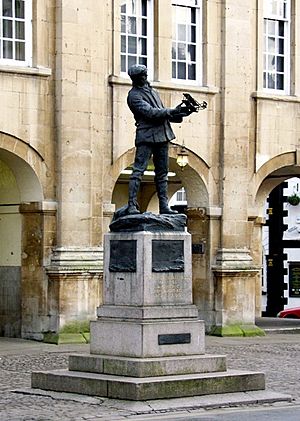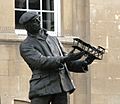Statue of Charles Rolls, Monmouth facts for kids
Quick facts for kids Statue of Charles Rolls |
|
|---|---|

The statue is in front of Monmouth's Shire Hall
|
|
| Artist | Sir William Goscombe John, R.A. |
| Year | 19 October 1911 |
| Medium | Bronze |
| Dimensions | 2.4 m (8 ft) |
| Location | Agincourt Square, Monmouth |
| 51°48′43.36″N 2°42′56.27″W / 51.8120444°N 2.7156306°W | |
|
Listed Building – Grade II
|
|
| Official name | Statue of C S Rolls |
| Designated | 15 August 1974 |
| Reference no. | 2229 |
A special statue stands in front of the Shire Hall in Agincourt Square, Monmouth, Wales. This statue honors Charles Rolls, a famous pioneer in aviation. It is made of Bronze and stands about 8 feet (2.4 meters) tall. The statue was designed by Sir William Goscombe John, and the base, called a plinth, was designed by Sir Aston Webb. This important statue is recognized as a Grade II* listed structure.
Contents
Who Was Charles Rolls?
Charles Stewart Rolls was born into an important family. He was the third son of John Rolls, 1st Baron Llangattock. His family lived at The Hendre, a large home north of Monmouth. The Rolls family owned a lot of land and helped the town and county of Monmouth in many ways.
A Pioneer's Life
Charles Rolls was very interested in new technologies. He was a true pioneer in both cars and airplanes. He is perhaps best known for co-founding the famous Rolls-Royce car company. But he also loved flying. In June 1910, the local council wanted to build a statue to celebrate his amazing flight. He was the first person to fly across the English Channel and back without stopping.
A Tragic End
Sadly, just one month after his famous flight, Charles Rolls died in an airplane accident. This happened at an airfield near Bournemouth in England. Because of this tragedy, the statue became a memorial. It now celebrates all of his life's achievements, not just his Channel crossing.
The Statue's Story
The statue was made by a company called A. B. Burton at the Thames Ditton Foundry. This foundry created many famous bronze statues around the world. These include the statue of Eros in Piccadilly Circus and the "Peace Quadriga" on Wellington Arch in London.
Unveiling the Memorial
The statue was officially revealed on October 19, 1911. Many important people and members of the public gathered for the event. Colonel Lord Raglan unveiled the statue.
What the Statue Shows
The statue shows Charles Rolls looking closely at a model of his biplane. This model is missing its tail plane. This detail is very important. It hints at the cause of the accident that killed Rolls. Before his final flight, the tail plane of his real airplane was changed to try and make it fly better.
The Dedication
The main words on the statue's base are written in all capital letters. They explain why the statue was built: "Erected by public subscription to the memory of the Honourable Charles Stewart Rolls, third son of Lord and Lady Llangattock as a tribute of admiration for his great achievements in motoring ballooning and aviation. He was a pioneer in both scientific and practical motoring and aviation and the first to fly across the channel from England to France and back without landing. He lost his life by the wrecking of his aeroplane at Bournemouth July 12, 1910. His death caused worldwide regret and deep national sorrow."
Images for kids
See also
 In Spanish: Estatua de Charles Rolls para niños
In Spanish: Estatua de Charles Rolls para niños









